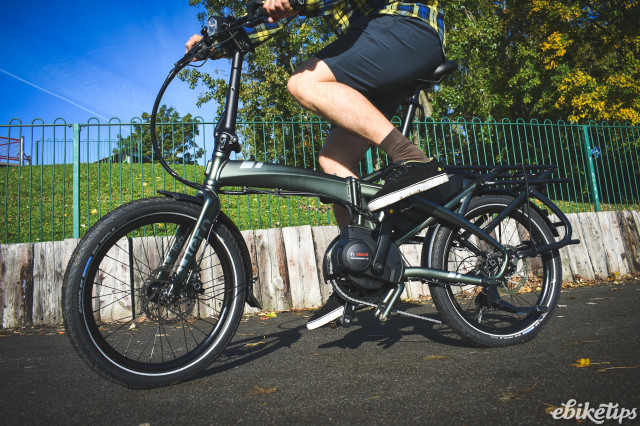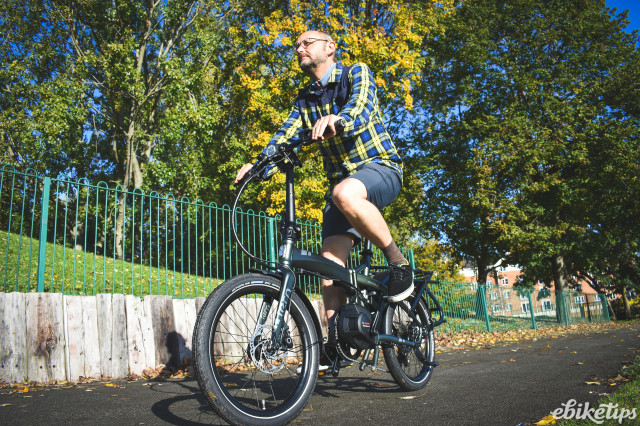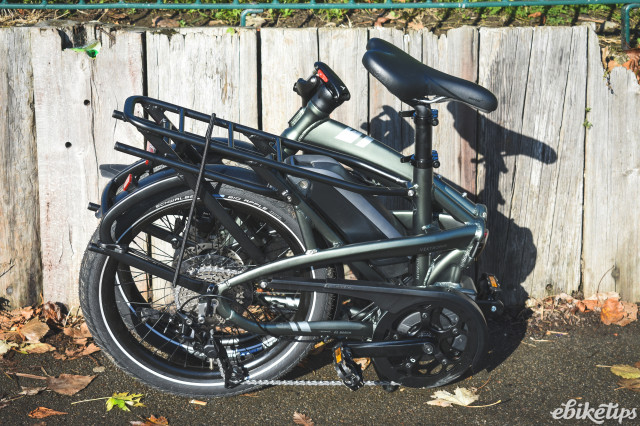Tern Vektron S10

Overview
- Superbly well built with a powerful motor
- Small bike, big load
- Adapts to a wide range of different sized riders
- On the heavy side
- Price ticket deserves a bigger battery than 400Wh
eBiketips reviewed the ‘gen 2’ upgrade of Tern’s electric folder, the Vektron, back in April 2019. Back then the bike had just undergone a redesign of the rear, which was elongated and strengthened to increase carrying capacity. This also cleverly allowed it to stand on its rear end when folded to reduce its footprint.
Buy the Tern Vektron S10 here
For MY2021 comes Vektron ‘gen 3’, which pretty much keeps the same frame design, but Tern have upgraded the motor performance across all three models in the range. They’ve also updated the frame detail, components, and colour options, all while maintaining similar price points. The main frame tweak means you get easier access to the charging port in the battery whilst it is on the bike (though it’s also easily removable).
The top-of-the-range ten-speed derailleur model of the Vektron S10, tested here, replaces the Active Line Plus mid-drive with a Bosch Performance Line motor that ups the support available by 15Nm to 65 Nm of torque, and improves the pedal assistance up to a possible maximum of 300% - an extra 30%. The Vektron Q9 and P7i (with nine derailleur and seven hub gears respectively) have been upgraded as well, and now feature a Bosch Active Line Plus motor adding 10Nm of torque (now rated at 50Nm) with pedal assist increased to 270%. The Active Line Plus does add some 300g of weight however, compared to the previously used Active Line.
All models come with Bosch’s 400Wh Powerpack battery. These are super reliable and have a great reputation for longevity but it would have been nice, given the pretty steep price tag, to see the 500Wh option fitted. The 400Wh and 500Wh Powerpacks are interchangeable if you want to upgrade.
The Ride
Before you even get moving you notice the huge adjustability of the seatpost and handlebars; there’s telescopic height adjustment on the former, and fore and aft and bar rotation adjustment on the latter. Indeed the Andros stem is a great design, with the large cam levers a joy to use... you really can get the bars exactly where you want them. All this means that the bike, Tern say, is suitable for riders between 4’10” and 6’5”.
The Bosch Performance Line motor allied with the small 20” wheels means really nippy performance, which is super fun and super practical for negotiating town traffic. The large volume Big Apple balloon tyres (with a Kevlar belt for puncture resistance) mean there’s also plenty of cushioning over bigger potholes and curb drops, all giving you the confidence to keep your speed up whatever state your local roads happen to be in. Hydraulic disc brakes – almost a standard feature on e-bikes today – give quick, powerful yet very controllable stopping power. The Purion display keeps things simple, with large plus and minus buttons allowing you to move between four power levels. You can also change the info displayed on the basic LCD screen and turn your lights on and off on the computer.
I’ve time-tested the Performance Line motor on my standard mile-long hill climb, and it actually matched Bosch’ top-of-the-range Performance Line CX motor; suggesting the latter is only really needed for demanding conditions such as rougher off-road riding, or pulling really heavy loads up very steep hills. Tern’s new version of their non-folding GSD packs the incredible Bosch Cargo Line mid-drive giving 400% assist, but the GSD has a stronger, longer frame rated for a gross weight of 200kg, compared to the Vektron’s 125kg. In other words, the Performance Line motor seems about right for the S10, and anything more powerful would most likely be overkill. The wider gearing range on the S10 (compared to the Q9 and P7i models) will also be a boon for riders living in hillier areas.
Like the ‘gen 2’ iteration, this latest version keeps the full complement of ‘extras’, in line with its theme of maximum practicality. A kickstand, mudguards, chainguard and LED lights are all present, and I loved the Tern Valo front light in particular as it was so easily adjustable. I could point it just where needed on the road ahead, even while riding.
Carry and Fold
The carrying capacity of the Atlas rack is just as impressive as the motor power, with a rating of 27kg that is certainly more than your average. Tern have clearly cottoned onto one of the big advantages of smaller-wheeled bikes, as the space freed up above the smaller wheels can now be utilised for carrying accessories such as child seats, or one of Tern’s carrying bags or baskets. Add a pair of Bucketload panniers for 48 litres worth of capacity, or even add another 23 litres in the form of the Market Basket. In fact, the Klickfix-compatible rack means it should take a wide range of luggage fittings. There’s also an attachment point on the front of the frame for an extra carrying rack if needed. Certainly I haven’t come across any other folding e-bike that will carry as much as the Vektron.
Folding is pretty intuitive. Like all folders there are just a few key things to ensure you do (and in the right order) to make sure you don’t end up in a tangle. Make sure the pedals and seatpost are in the correct position and unclamp the impressively-engineered frame hinge, then roll the front half of the bike to the back until the magnets engage. You then drop the handlepost by releasing the equally strong and rigid clamp.
I felt perhaps the magnet system could perhaps have been replaced with a stronger system such as the excellent anchor bolt mechanism as used on the non-electric Tern BYB. The folded package is reasonably compact for a 20” wheeled bike at 41 x 86 x 68 cm. Folded, the bike can stand either horizontally or vertically on the pegs provided, either underneath the bottom bracket area or at the back of the pannier rack. I felt a bit of adjustability designed into these would help to sit the bike perfectly level and stable if on slightly uneven surfaces. Still, the folding is pretty impressive overall.
If you want to use the Vektron in the same way as a Brompton or a Flit-style electric folder, lifting it up to waist height to store it on a train luggage rack, for example, you will be disappointed. At 22.65kg (by my scales) it’s just too heavy for that kind of use. For flat concourses and lift-equipped transport interchanges, however, it’s very feasible to use feature that allowed you to roll it along while it’s folded; and if you can roll it onto your chosen form of transport rather than having to lift it, the Vektron would be a cinch to take with you. If you need to negotiate stairs it’s probably easy to carry it up unfolded with the aid of the padded Porter+ saddle that you can hook over your shoulder. All this is a consequence of using the relatively heavy Bosch mid-drives; although lighter e-folders with smaller hub motors simply won’t have the power of the Vektron, nor the cargo-carrying versatility. It really is a case of horses for courses.
In summary, the latest S10 continues Tern’s approach of adding more power and more practicality to the Vektron range, which remains one of the very few Bosch-powered folders out there, with all the performance benefits that it brings. The extra power certainly makes sense; with the migration of some design features form the mini-cargo GSD models to the Vektron, the bikes are now so capable of carrying extra loads that the extra motor torque will be more than welcome in a ‘hill and load’ scenario. That they have kept prices to about the same mark (well for now at least) is a big plus point too, especially on a bike that is a feat of such complex engineering.












